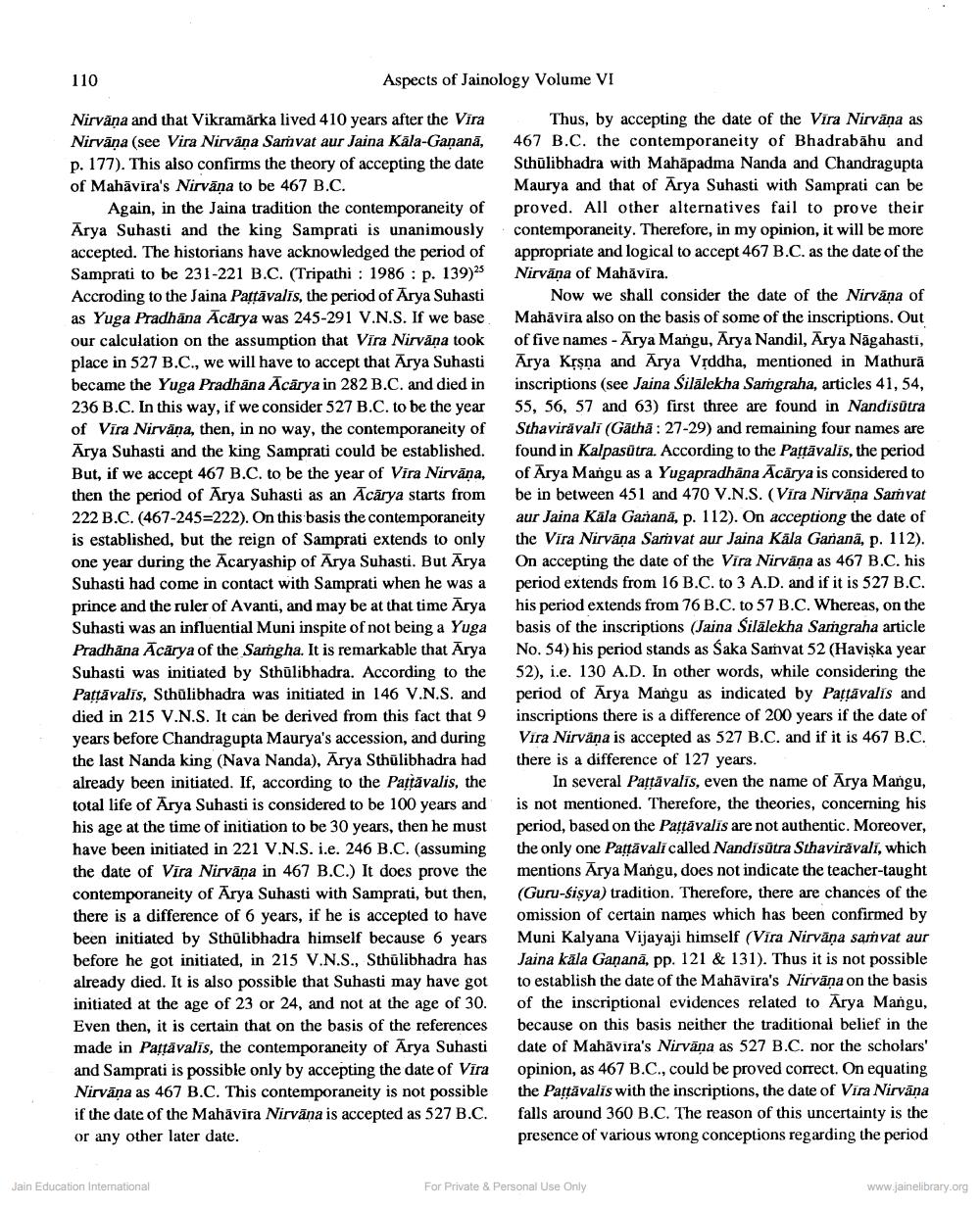Book Title: Reconsidering Date Of Nirvana Of Lord Mahavira Author(s): Sagarmal Jain Publisher: Z_Jaina_Literature_and_Philosophy_a_Critical_Approach_001936_HR.pdf View full book textPage 5
________________ 110 Aspects of Jainology Volume VI Nirvana and that Vikramărka lived 410 years after the Vira Nirvāna (see Vira Nirvana Sarvat aur Jaina Kala-Gananā, p. 177). This also confirms the theory of accepting the date of Mahāvīra's Nirvāņa to be 467 B.C. Again, in the Jaina tradition the contemporaneity of Arya Suhasti and the king Samprati is unanimously accepted. The historians have acknowledged the period of Samprati to be 231-221 B.C. (Tripathi : 1986 : p. 139)25 Accroding to the Jaina Pattāvalīs, the period of Arya Suhasti as Yuga Pradhāna Ācārya was 245-291 V.N.S. If we base our calculation on the assumption that Vīra Nirvāṇa took place in 527 B.C., we will have to accept that Arya Suhasti became the Yuga Pradhana Ācārya in 282 B.C. and died in 236 B.C. In this way, if we consider 527 B.C. to be the year of Vira Nirvana, then, in no way, the contemporaneity of Arya Suhasti and the king Samprati could be established. But, if we accept 467 B.C. to be the year of Vira Nirvana, then the period of Arya Suhasti as an Acārya starts from 222 B.C. (467-245=222). On this basis the contemporaneity is established, but the reign of Samprati extends to only one year during the Acaryaship of Arya Suhasti. But Arya Suhasti had come in contact with Samprati when he was a prince and the ruler of Avanti, and may be at that time Arya Suhasti was an influential Muni inspite of not being a Yuga Pradhāna Ācārya of the Samgha. It is remarkable that Arya Suhasti was initiated by Sthūlibhadra. According to the Pattāvalis, Sthūlibhadra was initiated in 146 V.N.S. and died in 215 V.N.S. It can be derived from this fact that 9 years before Chandragupta Maurya's accession, and during the last Nanda king (Nava Nanda), Arya Sthūlibhadra had already been initiated. If, according to the Pattāvalis, the total life of Arya Suhasti is considered to be 100 years and his age at the time of initiation to be 30 years, then he must have been initiated in 221 V.N.S. i.e. 246 B.C. (assuming the date of Vira Nirvana in 467 B.C.) It does prove the contemporaneity of Arya Suhasti with Samprati, but then, there is a difference of 6 years, if he is accepted to have been initiated by Sthūlibhadra himself because 6 years before he got initiated, in 215 V.N.S., Sthülibhadra has already died. It is also possible that Suhasti may have got initiated at the age of 23 or 24, and not at the age of 30. Even then, it is certain that on the basis of the references made in Pattavalis, the contemporaneity of Arya Suhasti and Samprati is possible only by accepting the date of Vira Nirvāṇa as 467 B.C. This contemporaneity is not possible if the date of the Mahāvīra Nirvana is accepted as 527 B.C. or any other later date. Thus, by accepting the date of the Vira Nirvana as 467 B.C. the contemporaneity of Bhadrabāhu and Sthūlibhadra with Mahāpadma Nanda and Chandragupta Maurya and that of Arya Suhasti with Samprati can be proved. All other alternatives fail to prove their contemporaneity. Therefore, in my opinion, it will be more appropriate and logical to accept 467 B.C. as the date of the Nirvana of Mahävira. Now we shall consider the date of the Nirvana of Mahāvira also on the basis of some of the inscriptions. Out of five names - Arya Mangu, Arya Nandil, Arya Nāgahasti, Arya Krsna and Arya VỊddha, mentioned in Mathurā inscriptions (see Jaina Silalekha Samgraha, articles 41, 54, 55, 56, 57 and 63) first three are found in Nandisutra Sthaviravali (Gäthä: 27-29) and remaining four names are found in Kalpasūtra. According to the Pattāvalis, the period of Arya Mangu as a Yugapradhana Ācārya is considered to be in between 451 and 470 V.N.S. (Vira Nirvana Samvat aur Jaina Kala Ganana, p. 112). On acceptiong the date of the Vira Nirvana Samvat aur Jaina Kala Garanä, p. 112). On accepting the date of the Vira Nirvana as 467 B.C. his period extends from 16 B.C. to 3 A.D. and if it is 527 B.C. his period extends from 76 B.C. to 57 B.C. Whereas, on the basis of the inscriptions (Jaina Silalekha Samgraha article No. 54) his period stands as Saka Samvat 52 (Havişka year 52), i.e. 130 A.D. In other words, while considering the period of Arya Mangu as indicated by Pattavalis and inscriptions there is a difference of 200 years if the date of Vira Nirvana is accepted as 527 B.C. and if it is 467 B.C. there is a difference of 127 years. I n several Pattavalis, even the name of Arya Mangu, is not mentioned. Therefore, the theories, concerning his period, based on the Pattavalis are not authentic. Moreover, the only one Pattävali called Nandisutra Sthaviravali, which mentions Arya Mangu, does not indicate the teacher-taught (Guru-Sisya) tradition. Therefore, there are chances of the omission of certain names which has been confirmed by Muni Kalyana Vijayaji himself (Vira Nirvana samvat aur Jaina kāla Gananā, pp. 121 & 131). Thus it is not possible to establish the date of the Mahāvira's Nirvana on the basis of the inscriptional evidences related to Arya Mangu, because on this basis neither the traditional belief in the date of Mahavira's Nirvana as 527 B.C. nor the scholars' opinion, as 467 B.C., could be proved correct. On equating the Pattāvalis with the inscriptions, the date of Vira Nirvana falls around 360 B.C. The reason of this uncertainty is the presence of various wrong conceptions regarding the period Jain Education International For Private & Personal Use Only www.jainelibrary.orgPage Navigation
1 ... 3 4 5 6 7 8 9
